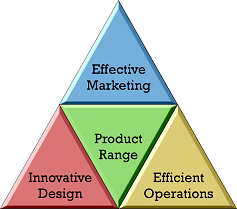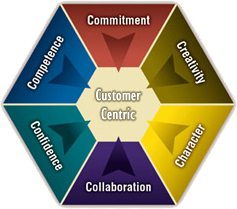The design and implementation of a customer-oriented strategy, having as a central concept the Customer Lifetime Value (CLV), represents a very good example of a complex operation which necessitates a radical reorganization of the company. Such reorganization is not necessarily in terms of physical structure, but rather in terms of philosophy and process management.
1. In a product-oriented organization, the firm studies the market and its own resources, attempting to create a better marketing-mix offer than the competitors.

The company's knowledge about its customers is often vague and general. Customers' segmentation is not very precise, the company taking advantage of the low cost of Internet communication to publish the offer online or to send promotional messages to its existing customers. The strategic objectives of the firm are also vague, since the company cannot predict accurately the customers' behavior. The results of the marketing campaign are usually measured calculating the ratio between the number of website visitors and the number of transactions concluded, or in the case of direct marketing, the number of offers per number of transactions. The management supervises the process, attempting to improve the offer in time and to stay ahead of competitors.
2. In the case of customer-centric online organizations, the integration of Customer Relationship Management (CRM) tools within the business operational structure offers the possibility to identify, assess, and define precisely the main customer segments in terms of profitability, and to build predictive customer profiles.

The strategic planning process involves the collaboration of various specialists, who try to establish realistic strategic objectives for each customer segment and to select the most appropriate marketing strategy to achieve these objective. The planning process incorporates both the strategic and operational perspectives, creating continuity and consistency among various strategic levels. The implementation process becomes more flexible, offering the possibility of a quick adjustment at the level of individual customer campaign. The integration of customer databases with data mining tools and customer management software permits the effective management of customer interaction at an individual level. The customer-firm interac tion is registered in the transaction history, creating the basis for the refinement of customer targeting in future marketing campaigns.
Ranjay Gulati, Harvard Business School professor and author of “Reorganize for Resilience: Putting Customers at the Center of Your Business,” on how to deliver what customers really want.
[youtube https://www.youtube.com/watch?v=W3tyEsTed4k]
As a result of implementing the CRM system, the firm-customer interaction will be more effective, resulting in increased customer satisfaction, increased customer loyalty, and increased profitability for the firm.
The flexible and interactive nature of the Internet offers the possibility to collect a vast amount of data about online customers and their interaction with the company. Processing this data provides a good basis to segment the market precisely, to predict the behavior of customers, and to implement one-to-one marketing campaigns.
On the other hand, the volatility of online markets requires an increased focus on customer relationship and customer loyalty. Research shows that a 5% increase in customer retention can increase the company profits by 20-100%. The loyalty-based model effectively explains success and failure in the digital business world.
In this situation, CRM processes become a major element of corporate strategy for many digital organizations. The adoption of CRM is being fuelled by the recognition that long-term relationships with customers are one of the most important assets of an organization and that information-enabled systems must be developed to retain ‘customer ownership'.







